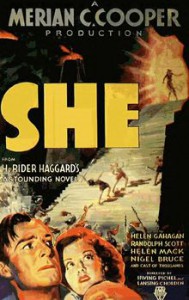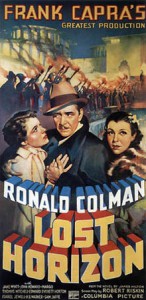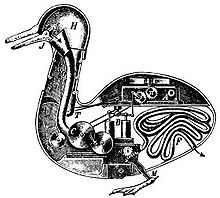Part One
Many months ago I wrote a blog entry about the 1930s covering in a very whirlwind and utterly selective manner a few people places and things which got my “interesting stuff” antennae twitching. At the time I called the 1930s my second favourite decade (there has been no change in rankings in the interim) and now 9 months later it’s time to complete my tribute to this era with a look back at some films from the libraries’ collection which makes me flip my lid.
She (1935) – Based on H. Rider Haggard’s 1887 novel She: A History of Adventure – Believe it or not this was already the 5th film adaptation of this work (and we think Hollywood recycles ideas now!) directed by the King of Stop Action Claymation Ray Harryhausen who only died just last May. The original plan was to film in colour but at the last minute was switched to black and white (it was finally colourizied by Harryhausen in 2006) She was unfortunately a disaster at the box office and in fact was thought lost for years until rather bizarrely an original print was found in Buster Keaton’s garage. The film features an amazing set of grand art deco design and starred Helen Gahagan in her only film role playing the menacing queen of Kor aka She (Who Must Be Obeyed). Five years after playing She Who Must Be Obeyed, Gahagan was one of the first women to be elected to the US House of Representatives as a left leaning Democrat, had a public love affair with Lyndon Johnson (seriously…LBJ!?) and eventually ended her political career after losing to Richard Nixon but not before she coined the nickname Tricky Dick.
Another adventure film based on a book was The Lost Horizon ( 1937). James Hilton wrote the book and Frank Capra (who had a run of classics in the 30s and 40s) directed the film. The story tells of group who stumble upon the hidden paradise of Shangri-La deep in the Himalayas after a rescue mission gets hijacked and subsequently crash lands. It turns out once you find paradise where nobody ages; it becomes a tough habit to quit. This film was also a bust initially and went way over budget. Like She, The Lost Horizon was also considered for colour film but was deemed too expensive, even so it still went way over budget and initially ended up with a whopping 6 hours run time eventually whittled down to a more manageable 134 minutes. Somehow through all the cutting and re-releasing and re-editing a total of 7 minutes of the film has been lost forever which explains why in the library’s dvd contains just the audio track and various promotional stills which fill in the gap of the missing footage. It’s a bit jarring upon first viewing but “lost forever “ is “lost forever” so what are you gonna do?








